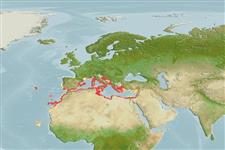Environment: milieu / climate zone / depth range / distribution range
Écologie
marin; profondeur 0 - 100 m. Tropical; 44°N - 14°N, 26°W - 36°E
Eastern Central Atlantic: Cape Verde and the Canary Islands. Also reported from Lebanon in the eastern Mediterranean. Its exact distribution and abundance are unknown because most published records do not separate it from Sphyraena sphyraena. Also in Azores Islands (Ref. 44330).
Taille / Poids / Âge
Maturity: Lm ? range ? - ? cm
Max length : 128 cm FL mâle / non sexé; (Ref. 40637); common length : 40.0 cm SL mâle / non sexé; (Ref. 11101); poids max. publié: 8.2 kg (Ref. 40637)
Description synthétique
Clés d'identification | Morphologie | Morphométrie
Body slender, fusiform with conical, hydrodynamical snout. Mouth long, with low protractile capacity and with prognatic lower jaw, has two rows of long canine-like teeth. Has no scale on preoperculum. Upper half of body has numerous vertical dark bands extending below the lateral line in the anterior part of the flanks (Ref. 44330).
Its habits are probably similar to those of the phylogenetically closely related Sphyraena sphyraena (Ref. 6949). Feeds on cephalopods, crustaceans and fishes. Caught in trammel nets and beach seines (Ref. 11101).
Life cycle and mating behavior
Maturities | Reproduction | Spawnings | Egg(s) | Fecundities | Larves
De Sylva, D.P., 1990. Sphyraenidae. p. 860-864. In J.C. Quero, J.C. Hureau, C. Karrer, A. Post and L. Saldanha (eds.) Check-list of the fishes of the eastern tropical Atlantic (CLOFETA). JNICT, Lisbon; SEI, Paris; and UNESCO, Paris. Vol. 2. (Ref. 6949)
Statut dans la liste rouge de l'IUCN (Ref. 130435)
Menace pour l'homme
Harmless
Utilisations par l'homme
Pêcheries: commercial
Outils
Articles particuliers
Télécharger en XML
Sources Internet
Estimates based on models
Preferred temperature (Ref.
123201): 15.09 - 21.5475, mean 18.83 °C (based on 230 cells).
Phylogenetic diversity index (Ref.
82804): PD
50 = 0.5000 [Uniqueness, from 0.5 = low to 2.0 = high].
Bayesian length-weight: a=0.00724 (0.00339 - 0.01546), b=2.92 (2.74 - 3.10), in cm total length, based on LWR estimates for this Genus-body shape (Ref.
93245).
Niveau trophique (Ref.
69278): 4.3 ±0.5 se; based on diet studies.
Generation time: 12.3 ( na - na) years. Estimated as median ln(3)/K based on 1
growth studies.
Résilience (Ref.
120179): Très faible, temps minimum de doublement de population supérieur à 14 ans (Preliminary K or Fecundity.).
Fishing Vulnerability (Ref.
59153): High to very high vulnerability (69 of 100).
Nutrients (Ref.
124155): Calcium = 28.6 [14.0, 87.5] mg/100g; Iron = 0.551 [0.256, 1.217] mg/100g; Protein = 19.6 [17.6, 21.3] %; Omega3 = 0.135 [0.059, 0.317] g/100g; Selenium = 52.3 [20.6, 141.2] μg/100g; VitaminA = 12.8 [2.3, 74.9] μg/100g; Zinc = 0.508 [0.306, 0.883] mg/100g (wet weight);
